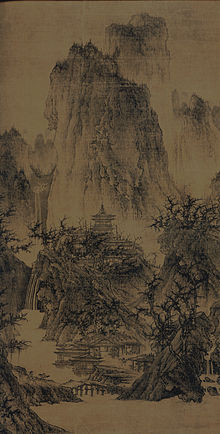Li Cheng (painter)
| Li Cheng | |
|---|---|

A Solitary Temple Amid Clearing Peaks 晴峦萧寺. Ink and light color on silk. 111.76 x 55.88 cm. Nelson-Atkins Museum of Art
|
|
| Born | 919 |
| Died | 967 |
| Nationality | Chinese |
| Known for | Painting |
| Movement | Northern Landscape style |
Li Cheng (Chinese: 李成; pinyin: Lǐ Chéng; Wade–Giles: Li Ch'eng; 919–967), Courtesy name Xiánxī (咸熙), was a Chinese painter from Qingzhou (now part of Weifang, Shandong) during the Five Dynasties and Ten Kingdoms and early Song Dynasty. His ancestral lineage was with the Tang Dynasty imperial family, the Li (李) family, which had fallen out of power in 907 with the collapse of the Tang Empire.
Li Cheng, Fan Kuan, and Guan Tong together became known as the "three great rival artists". He did many landscape paintings with diluted ink, known as "treating ink like gold", which gives the appearance of being in a foggy dream. At that time, he was considered the best landscape painter of all time. He was known to have carried on an artistic dialogue with Wu Daoxuan through their respective paintings. Li Cheng primarily portrayed Shandong area landscapes in his paintings. Artists of later generations, such as Guo Xi, modeled their teaching on his painting style and methods.
His works include “Jigger", "Joy in Fishing", "Cold crow", and "Landscape". One extant painting, "Reading Stele Nest Stone", was a collaboration between him and Wang Xiao.
...
Wikipedia
